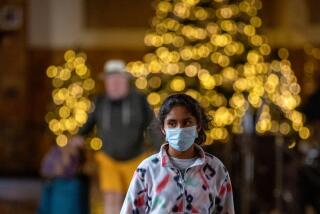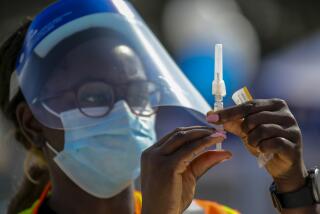Masks less effective than they might look
- Share via
The visible symbol of the H1N1 flu outbreak last spring seemed to be face masks. Suddenly, they were everywhere -- in airports and waiting rooms, on buses and trains. Many drugstores sold out of masks. As the nation girds itself for a renewed fall outbreak, however, masks may make a reappearance.
--
Should I wear a mask?
In general, the Centers for Disease Control and Prevention does not recommend use of face masks or respirators in non-healthcare settings. But there are exceptions. Because the novel strain of H1N1 influenza has led to a pandemic, people who are ill with the virus should consider wearing a mask around other people, if tolerable. People who are at risk for severe illness from the flu should wear a mask or respirator if they are caring for someone with the flu and should consider wearing one if there is an outbreak of flu in the community. People who are not at high risk for flu complications could consider wearing one if there is an outbreak in the community, but it’s not recommended.
--
What kind is most effective?
There are two types of protection -- face masks and respirators. Masks are loose-fitting and designed to stop the spread of droplets from the person wearing the mask, not to protect the wearer from viruses. Respirators are close-fitting and more expensive. They are designed to reduce exposure to airborne particles. The CDC recommends N95 respirators for healthcare workers. The Food and Drug Administration has approved of four models of respirators for use by the general public to help reduce exposure during a flu pandemic: 3M respirators models 8612F and 8670F, and Pasture Pharma respirator models F550G and A520G. These masks have been tested and shown to achieve a satisfactory fit for most adults. It’s easiest to find them online.
--
But do they really work?
It’s still unclear how influenza is largely spread, whether through direct contact, the spray of droplets from an infected person to an uninfected person (within a proximity of six feet), or through inhaling smaller, airborne particles.
However, studies show that fit-tested N95 respirators filter out 95% to 99% of influenza particles and have maximum effectiveness when fitted properly to the face. A study published last year in the journal PLoS One found that respirators are more efficient than masks at reducing the transmission of respiratory infections. Another study, published in April in the journal Risk Analysis, concluded that N95 respirators combined with the use of humidifiers and ventilation in a household improves infection control by 20% to 70%, according to a mathematical model.
--
Do the cheap ones offer any protection?
If a mask fits tightly around your face, it can reduce the chances of breathing in germs and stopping the spread of germs from the wearer. The key is fit. They are designed to fit tightly over the mouth and nose, with no gaps. Gaps allow air to pass without being filtered. Masks are probably most useful in crowded settings, such as classrooms and airplanes or if you are in close contact with an infected person (within six feet). Masks shouldn’t replace other precautions such as hand-washing.
--
Is there a correct way to wear a mask?
Wash your hands with soap and water before putting on a mask. Make sure it fits tightly and that no hair, clothing or jewelry comes between the mask and your face. Inexpensive masks have a limited life span -- only about 30 minutes -- because they become moist and may lose shape and allow particles in. They should be removed if they become wet or damaged. Never reuse a mask. When a mask is removed, throw it away in a closed waste container, wash your hands and put on a new mask. For tips on fitting a respirator to your face correctly, see www .cdc.gov/h1n1flu/eua/pdf/n95 factsheet.pdf.
--
Can children wear masks?
Masks and respirators are not designed to fit children. Children may have difficulty breathing while wearing a mask and may not be able to let others know if they are having trouble breathing.
--






